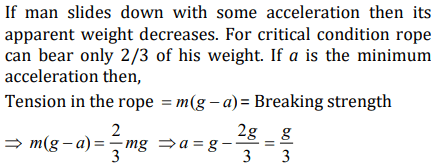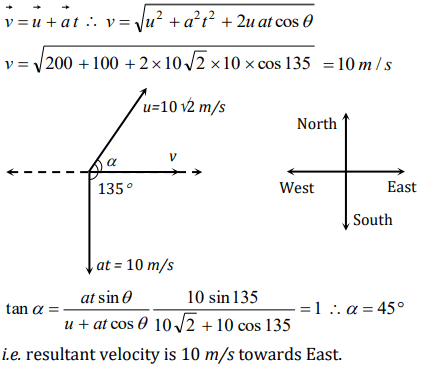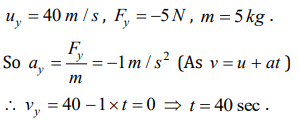1. A man of weight 80 kg is standing in an elevator which is moving with an acceleration of \[6m\diagup s^{2}\] in upward direction. The apparent weight of the man will be \[\left(g=10 m\diagup s^{2}\right)\]
a) 1480 N
b) 1280 N
c) 1380 N
d) None of these
Explanation: The apparent weight of man, R = m(g + a) = 80(10 + 6) = 1280 N
2. A force of 100 dynes acts on a mass of 5 gram for 10 sec. The velocity produced is
a) 2000 cm / sec
b) 200 cm / sec
c) 20 cm / sec
d) 2 cm / sec
Explanation:

3. When the speed of a moving body is doubled
a) Its acceleration is doubled
b) Its momentum is doubled
c) Its kinetic energy is doubled
d) Its potential energy is doubled
Explanation: Its momentum is doubled
4. A body of mass m collides against a wall with a velocity v and rebounds with the same speed. Its change of momentum is
a) 2 mv
b) mv
c) – mv
d) Zero
Explanation: \[\triangle\] p = pi - pf = mv-(-mv) = 2mv
5. A thief stole a box full of valuable articles of weight W and while carrying it on his back, he jumped down a wall of height ‘h’ from the ground.
Before he reached the ground he experienced a load of
a) 2W
b) W
c) W/2
d) Zero
Explanation: In the condition of free fall apparent weight becomes zero.
6. N bullets each of mass m kg are fired with a velocity v \[m s^{-1}\] at the rate of n bullets per second upon a wall. The reaction offered by the wall to
the bullets is given by
a) nmv
b) \[\frac{Nmv}{n}\]
c) \[n\frac{Nm}{v}\]
d) \[n\frac{Nv}{m}\]
Explanation:

7. If a body of mass m is carried by a lift moving with an upward acceleration a, then the forces acting on the body are (i) the reaction R on the
floor of the lift upwards (ii) the weight mg of the body acting vertically downwards. The equation of motion will be given by
a) \[R=mg- ma\]
b) \[R=mg+ ma\]
c) \[R=ma- mg\]
d) \[R=mg\times ma\]
Explanation: \[R = mg + ma\]
8. With what minimum acceleration can a fireman slides down a rope while breaking strength of the rope is\[\frac{2}{3}\] of his weight
a) \[\frac{2}{3}g\]
b) g
c) \[\frac{1}{3}g\]
d) Zero
Explanation:

9. The velocity of a body at time t = 0 is \[10\sqrt{2}m\diagup s\] in the north-east direction and it is moving with an acceleration of \[2 m\diagup s^{2}\] directed towards the south.
The magnitude and direction of the velocity of the body after 5 sec will be
a) 10 m/s, towards east
b) 10 m/s, towards north
c) 10 m/s, towards south
d) 10 m/s, towards north-east
Explanation:

10. A body of mass 5 kg starts from the origin with an initial velocity \[\vec{u}=30\hat{i}+40\hat{j}ms^{-1}\] . If a constant force
\[\vec{F}=-\left(\hat{i}+5\hat{j}\right)N\] acts on the body, the time in which the y–component of the velocity becomes zero is
a) 5 seconds
b) 20 seconds
c) 40 seconds
d) 80 seconds
Explanation:
